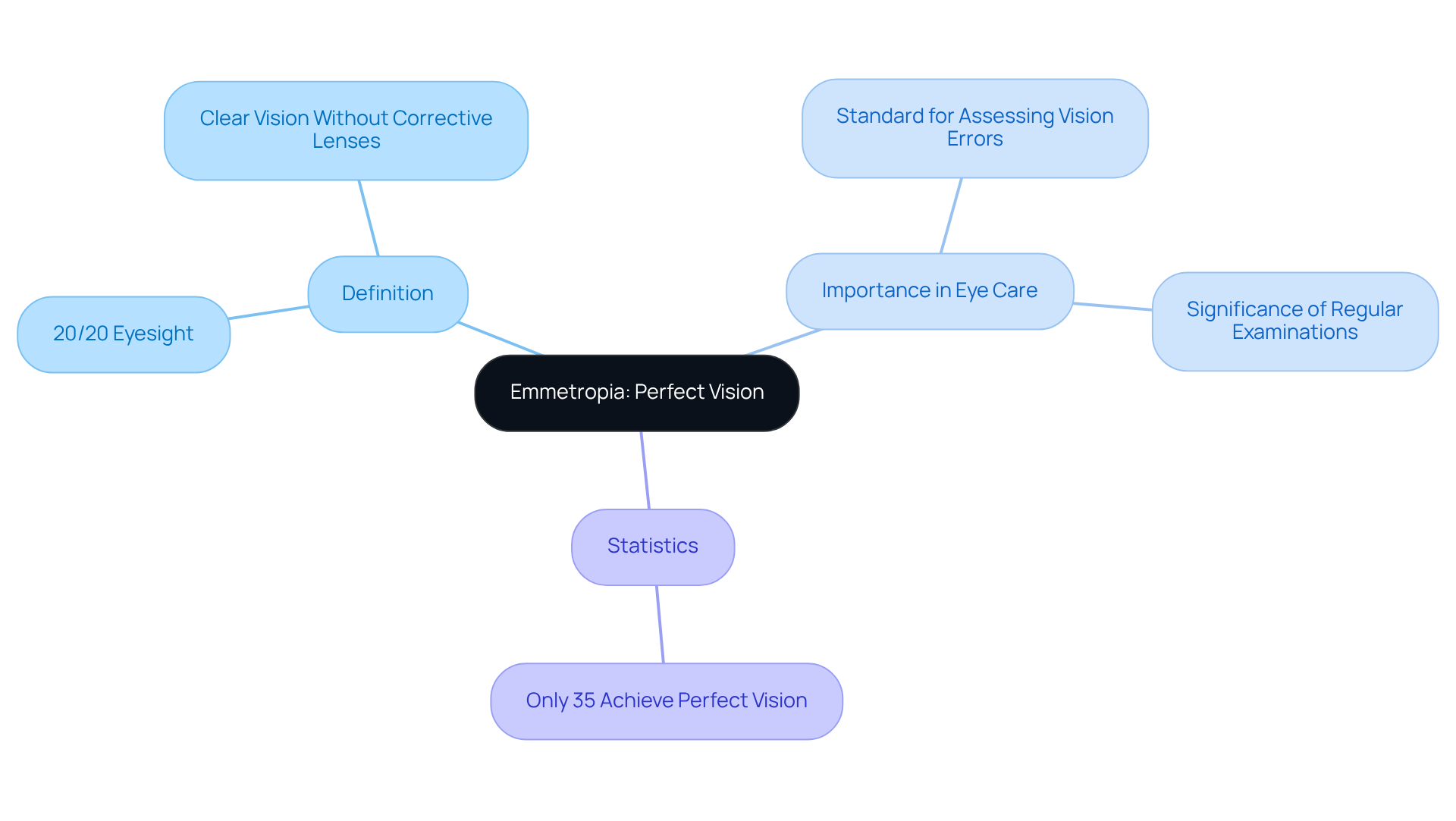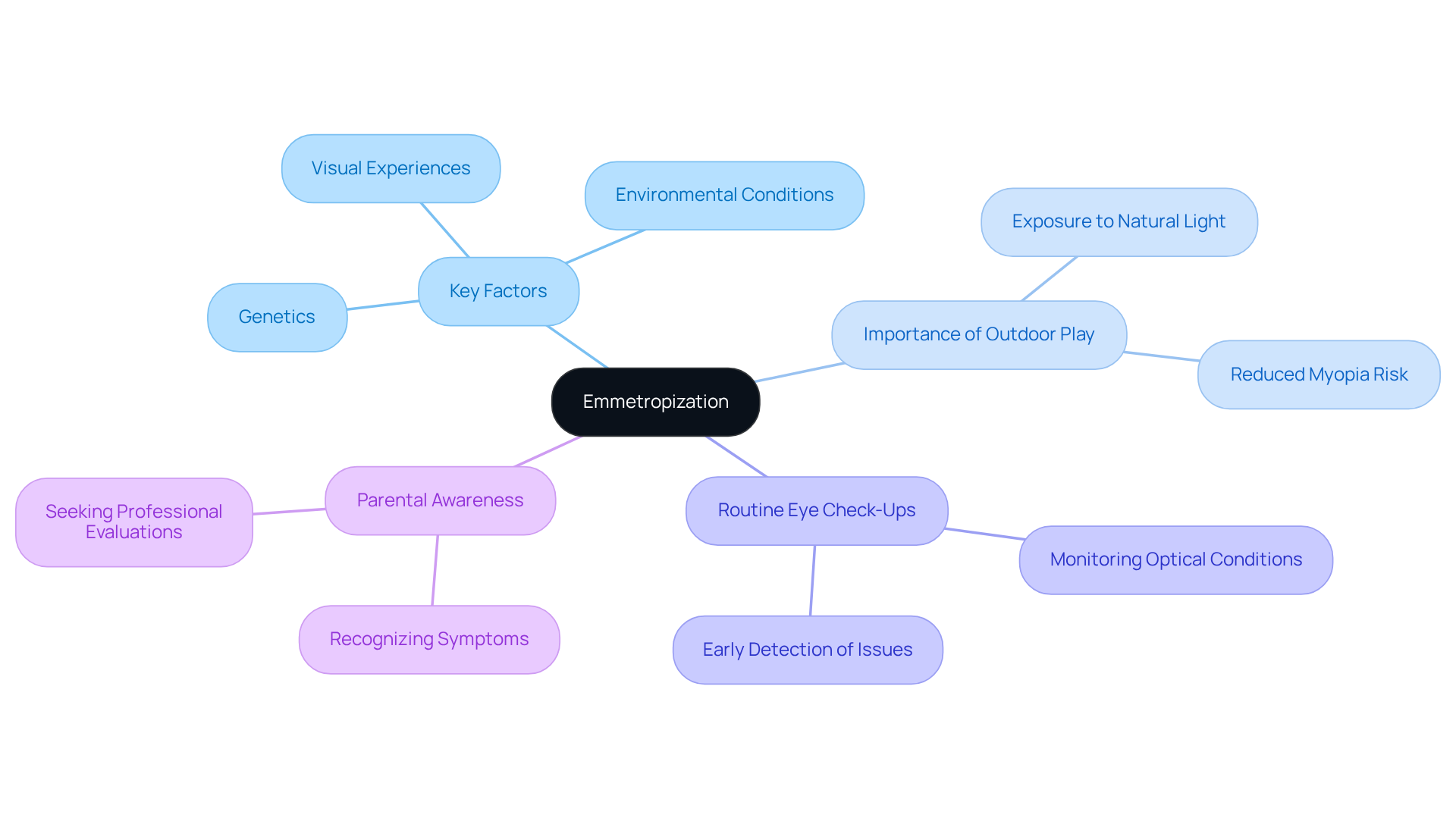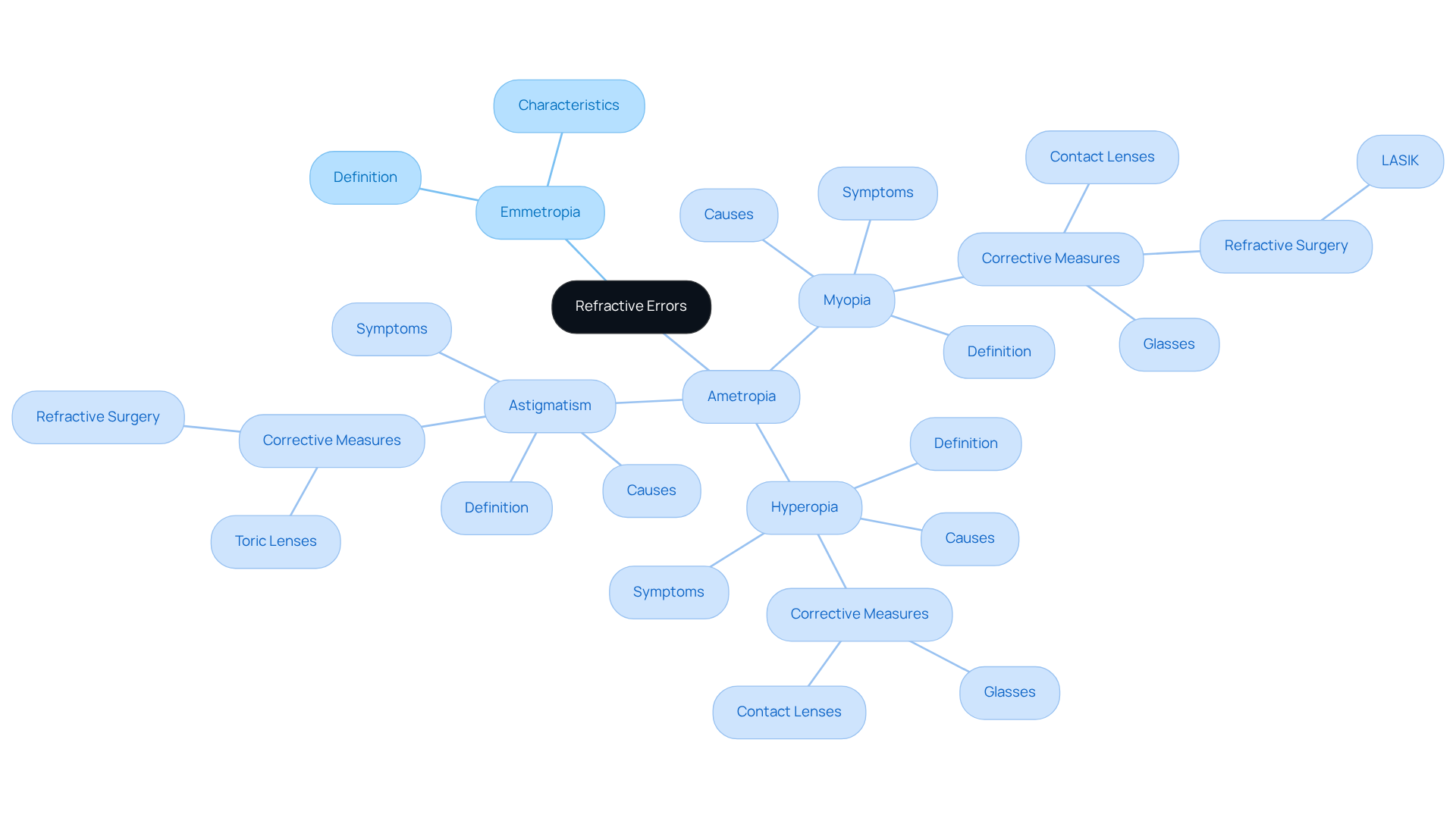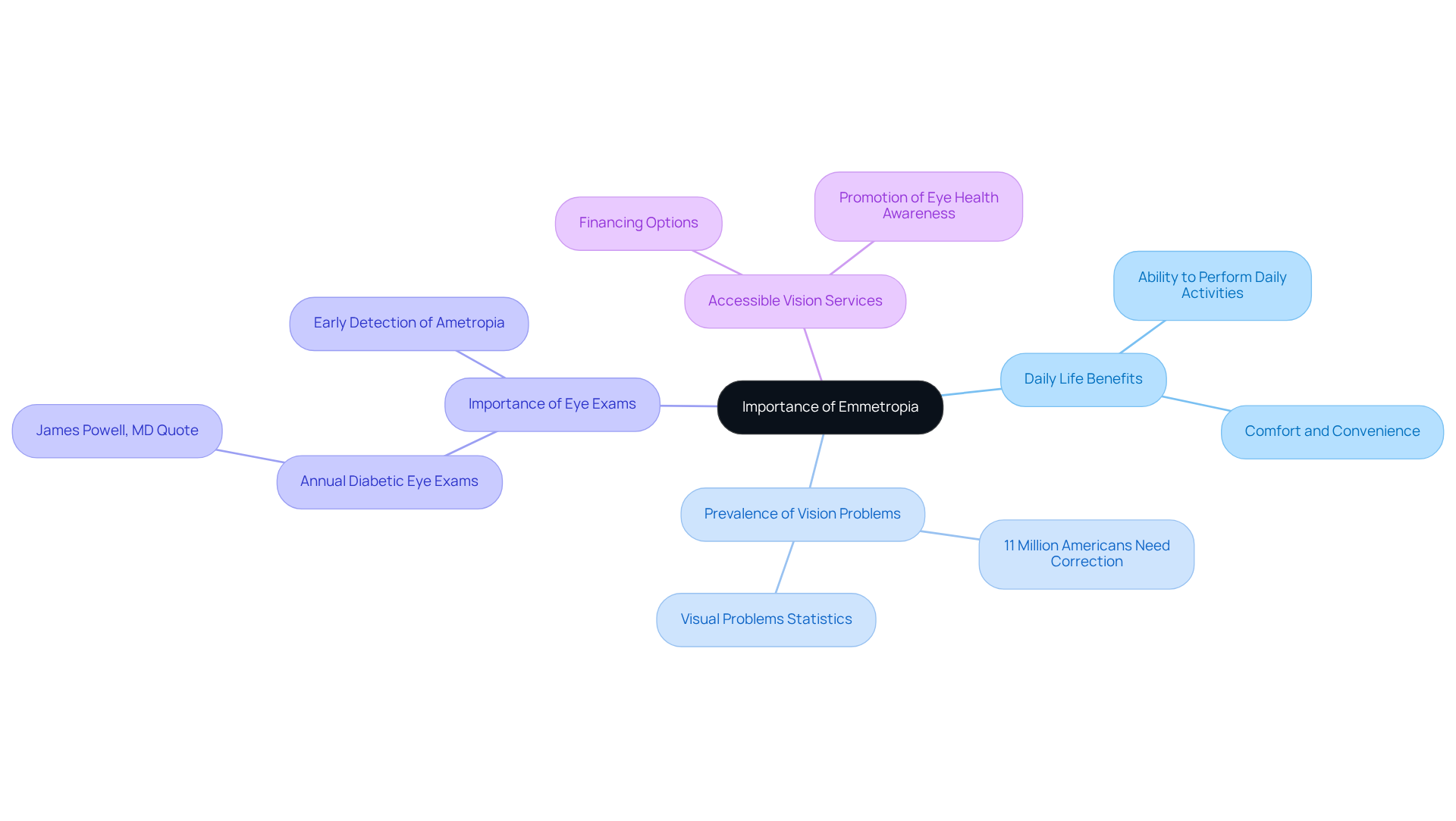Posted by: Northwest Eye in General on June 27, 2025
Overview
Emmetropia, often referred to as perfect vision, is the eye’s remarkable ability to focus light directly on the retina. This allows for clear sight without the need for corrective lenses, playing a vital role in your overall eye health.
We understand that maintaining emmetropia can significantly enhance your daily life and comfort. It’s important to remember that regular eye examinations are essential. These check-ups help prevent and address refractive errors like ametropia, which affects millions of people around the world.
Taking care of your vision is a journey we are here to support you with.
Introduction
Emmetropia, often referred to as perfect vision, represents a state where light rays focus precisely on the retina, allowing for clear sight without the need for corrective lenses. This condition is not merely a benchmark for visual acuity; it plays a crucial role in overall eye health and the prevention of refractive errors.
We understand that only a fraction of the global population achieves this standard, which can be concerning. What factors might hinder the journey to emmetropia? How can individuals protect their vision against the increasing prevalence of ametropia? These are important questions that deserve our attention.
Define Emmetropia: The Concept of Perfect Vision
The clinical term for ideal sight, often referred to as ‘20/20 eyesight,’ is emmetropia. In an emmetropic eye, the direct focus of light rays on the retina allows for clear vision without the need for corrective lenses. This condition reflects the perfect alignment of the eye’s optical components, such as the cornea and lens, with its axial length, ensuring optimal visual acuity at a distance.
We understand that vision health is important to you. Understanding emmetropia is crucial for eye care specialists, as it acts as a and overall eye health. It’s common to feel concerned about your eyesight, and knowing that only about 35% of people globally achieve perfect vision without corrective measures highlights the significance of regular eye examinations.
We encourage you to seek care if you have any sight issues. Routine check-ups can help identify potential problems early and provide you with the best options for maintaining your vision health.

Explore Emmetropization: How the Eye Achieves Perfect Vision
Emmetropization is a complex yet essential process through which the eye modifies its shape and focusing ability to attain emmetropia, or optimal sight. We understand that this dynamic adjustment can feel overwhelming, especially for parents. It begins in infancy and continues throughout childhood, involving both passive and active mechanisms. As the eye develops, it responds to visual stimuli, ensuring that light rays focus accurately on the retina.
Several key factors influence this process, including genetics, environmental conditions, and visual experiences. Research shows that children who spend time outdoors are less likely to develop myopia, as exposure to natural light promotes healthy eye growth and effective emmetropia. Pediatric eye care experts emphasize the importance of these environmental factors, encouraging outdoor play as a proactive approach to minimizing vision errors in children.
It’s also important to be aware that conditions like amblyopia and optical errors can lead to unsuccessful eyesight assessments. This highlights the significance of routine eye check-ups to monitor your child’s optical condition. We understand that as parents, you want the best for your children, and in infants may indicate a blocked tear duct rather than an infection. This further emphasizes the need for professional evaluations to ensure healthy eye development. We are here to help you through this process, providing the support and guidance you need for your child’s eye health.

Differentiate Emmetropia from Ametropia: Understanding Refractive Errors
Ametropia encompasses various refractive errors that hinder light from focusing correctly on the retina, leading to unclear vision. The main types of ametropia include myopia (nearsightedness), hyperopia (farsightedness), and astigmatism. In contrast, the ideal state of vision is emmetropia, where light focuses precisely on the retina without the need for corrective lenses. Understanding this distinction is vital for eye specialists, as it informs the diagnosis and treatment strategies tailored to individual visual needs.
We understand that refractive errors can be a significant concern for many. Statistics show that uncorrected errors contribute to visual impairment in over 101 million people worldwide. Myopia, in particular, is on the rise, with projections indicating that by 2050, the prevalence among children and teens could exceed 740 million cases. This alarming trend underscores the necessity for effective interventions, such as those provided by Northwest Eye.
Eye care professionals emphasize the importance of recognizing the different forms of ametropia. Myopia often begins in childhood and can worsen with age, while hyperopia may lead to challenges in focusing on nearby objects. Astigmatism, characterized by an irregular curvature of the cornea, can result in distorted vision at any distance. Each type of ametropia requires specific corrective measures, such as glasses, contact lenses, or refractive surgery, to restore optimal sight.
Real-life examples illustrate the positive outcomes of treating ametropia. Patients who undergo LASIK surgery for myopia frequently report significant improvements in their quality of life, enjoying enhanced vision without the need for glasses or contacts. Similarly, individuals treated for astigmatism with toric lenses often achieve greater visual clarity, enabling them to engage more fully in daily activities. Additionally, the combined optical package offered at Northwest Eye allows patients with astigmatism to attain both close and distant vision, reducing their reliance on glasses.
To make these treatments more accessible, Northwest Eye provides financing options for qualified candidates, including 0% interest financing for up to 24 months through CareCredit® and low-interest financing options for up to 60 months, with payments as low as $100 per month. This flexibility ensures that patients can pursue the necessary interventions without financial strain.
In summary, recognizing the difference between emmetropia and ametropia is crucial for . By understanding these concepts and the comprehensive solutions offered at Northwest Eye, including the Single Distance Astigmatism Package and blended sight options, patients can make informed choices regarding their eye health and pursue suitable treatments to enhance their quality of life. We are here to help you through this process.

Assess the Importance of Emmetropia in Eye Health and Vision Care
It is crucial for optimal eye health and quality of life to maintain emmetropia. We understand that individuals with perfect eyesight can perform daily activities without the hindrance of corrective lenses, leading to greater comfort and convenience. Research suggests that approximately 11 million Americans above 12 years old need eyesight correction. This highlights the prevalence of visual problems and the importance of maintaining emmetropia.
Furthermore, regular eye examinations are essential for detecting any changes in refractive status and monitoring overall eye health. It’s common to feel concerned about potential issues, but early detection can prevent the progression of ametropia and other eye conditions. As James Powell, MD, emphasizes, ‘Annual diabetic eye exams are extremely important for people living with diabetes to ensure necessary treatment is received to protect their vision.’
At Northwest Eye, we recognize the significance of accessible vision services. That’s why we provide a range of financing options and payment plans to make the expenses of treatment straightforward and manageable. We encourage you to take our to see if you’re an ideal candidate for Laser Vision Correction. By promoting awareness of emmetropia and its significance, we aim to empower you to prioritize your eye health and pursue timely interventions when needed.

Conclusion
Understanding emmetropia is essential for appreciating the significance of perfect vision and its impact on overall eye health. Emmetropia, characterized by the precise focus of light on the retina, allows individuals to enjoy clear vision without corrective lenses. This ideal state not only enhances daily activities but also serves as a benchmark for assessing various refractive errors. It is a critical concept for eye care professionals, and we understand how important it is for you to have clarity in your vision.
Throughout this article, we shared key insights about the processes involved in achieving emmetropia, including emmetropization. This process is influenced by genetics, environmental factors, and visual experiences. The distinction between emmetropia and ametropia highlights the prevalence of refractive errors such as myopia, hyperopia, and astigmatism, which can significantly affect vision quality. We emphasize the importance of regular eye examinations and early detection of vision problems, showcasing the proactive steps you can take to maintain your eye health.
Ultimately, prioritizing emmetropia not only leads to improved quality of life but also empowers you to make informed decisions regarding your vision care. By recognizing the importance of maintaining optimal eyesight and seeking timely interventions, you can safeguard your vision and enhance your overall well-being. Embracing regular eye check-ups and understanding the available treatment options can pave the way for a future of clearer vision and healthier eyes. Remember, we are here to help you through this process, and your journey to better vision starts with taking that first step.
Frequently Asked Questions
What is emmetropia?
Emmetropia is the clinical term for ideal sight, commonly referred to as ’20/20 eyesight.’ It describes a condition where light rays focus directly on the retina, allowing for clear vision without the need for corrective lenses.
What does an emmetropic eye look like?
An emmetropic eye has its optical components, such as the cornea and lens, perfectly aligned with its axial length, ensuring optimal visual acuity at a distance.
Why is understanding emmetropia important for eye care specialists?
Understanding emmetropia is crucial for eye care specialists as it serves as a standard for assessing vision errors and overall eye health.
How common is perfect vision (emmetropia) among people?
Only about 35% of people globally achieve perfect vision without corrective measures, highlighting the importance of regular eye examinations.
What should I do if I have concerns about my eyesight?
If you have any sight issues, it is encouraged to seek care. Routine check-ups can help identify potential problems early and provide the best options for maintaining your vision health.






